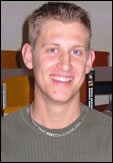|

 |
It
Runs Through A River
Engineering students see whether their design creation
will carry its load to the other side
|
The timer starts and the next potential River
Queen is off and running. Well, these River Queens are not
actually running, but instead are rolling, falling and paddling
to the finish line.
The River Queen is a design project given to the MEC E 260
students in late January. Using limited materials, teams of
four students had to design and build a vehicle that could
transport a "load" across the perilous waters and
past the ice chunks simulated in the mechanical engineering
design lab.
Using materials such as sheet metal, wheels, gears, a motor,
the always important surgical tubing, springs and latex, the
teams had to build a vehicle robust enough to endure the pressures
of the course.
The only other restriction? The vehicle had to start from
and fit within a 0.5-by-one-metre starting block.
The vehicle had to carry a weight of at least one kilogram
across a river (simulated by a track with the qualities of
a cross section of river) covered in pack ice, (simulated
by a layer of Styrofoam packing chips three to four centimetres
deep) in a time of five minutes or less. Points were given
to each team based on largest load and fastest time.
Students had 10 weeks to design, build and test their machine
before competition day. Within this short period, including
a limited amount of machine time and only two and a half hours
with a machinist, this task proved to be a challenging one.
Kristie Bruemmer, a student in the MEC E 260 class, says that
while there were many designs that could work, it was a matter
of "designing things that are buildable."
The project teaches students to think ahead and pay attention
to the details of the vehicle, she says. "Every time
we tried to do something sloppy, we had to do it again."
In Ms. Bruemmer's group this was especially true of the gearbox.
"It was a finnicky thing."
Each group had a box of common hand tools to help them make
their vehicle. As well, students were given use of some shop
machines, such as the band saw and the drill press. For the
finer details and precision parts such as gears and axles,
students made use of machinists. The machinists' skill made
it easier for students without much machining background to
obtain correctly fitting parts.
Many Ways Across
Designs varied dramatically. Some machines harnessed the power
of the motor, and some harnessed the power that could be stored
in surgical tubing and springs. Some groups used the potential
energy due to gravity to run their machines.
There were machines that went across the water, those that
went through the water and some that did a bit of both. Paddleboats
had quite a bit of trouble due to the thick layer of "ice"
that covered the water.
The machines that used gravity and literally opened up (in
the shape of an upside-down V that gradually flattens out)
found it difficult to carry heavier weights across the river
without their machine bending. It was one of these machines,
however, that clocked the fastest time across.
The machines that were able to carry the most weight were
those that went underneath the layer of ice and traveled on
the river floor to get to the finish line. This is the design
that Ms. Bruemmer's group finally decided on for their machine.
Bearing the Burden
But there were still difficulties. For example, when the vehicle
would break through the top layer of "ice," the
chips tended to gum up the wheels. This was fixed in many
cases by adding a cow-catcher-type element to the front of
the vehicle, much like the one on a train's engine.
As well, the team initially assumed that the motor would
short out if it came into contact with water while running.
But the motor ran fine in the water, waterproofed or not.
After many weeks of design, machining and much trial and
error, groups were given time to do an insurance run for their
vehicle. This was an allotted test time to find out if vehicles
needed any extra work. The insurance run was crucial to the
teams' success in the actual competition.
The Day Arrives
Competition day finally arrived, and with more than 40 groups
plus spectators, the machining area in the MEC E building
was packed. What was expected to be a short competition turned
out to be an 11-hour marathon with staff taking only 15
minutes for lunch. The top group for load carried an impressive
nine kg across the river while the top group for speed finished
the five-metre course in a blistering six seconds.
Thanks go out to the machinists who volunteered their time.
Special thanks go to Dr. Walied Moussa, P.Eng., and Dr. Roger
Toogood, P.Eng., the MEC E 260 professors heading the project.
|




